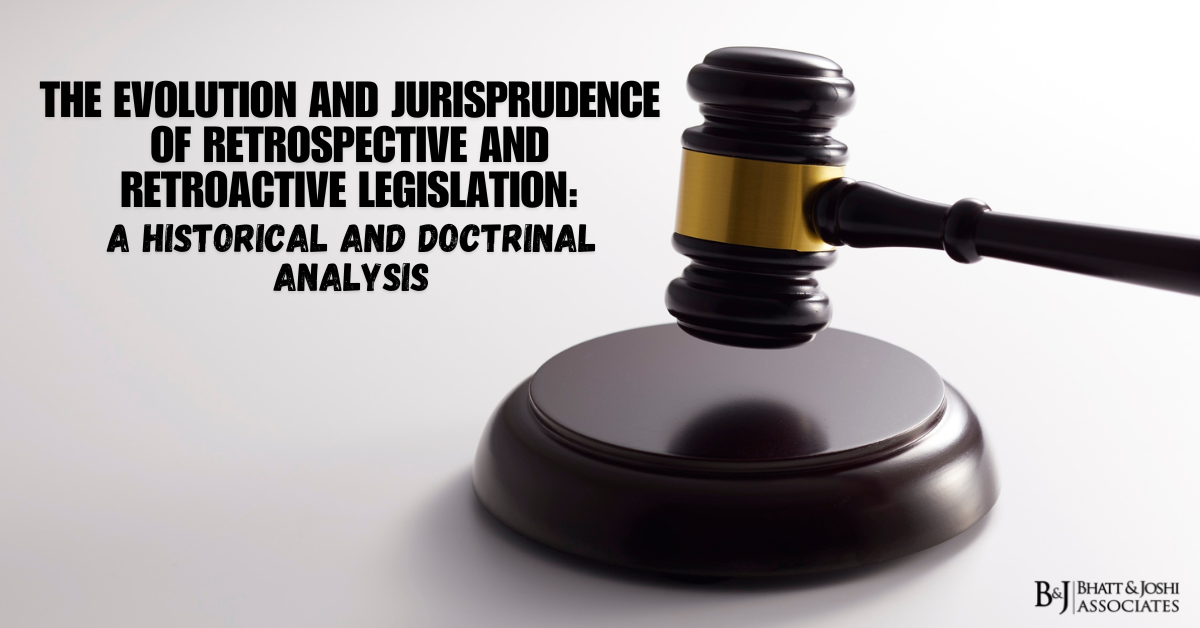I. Historical Foundations of Retrospective and Retroactive Law making
1.1 Origins in Roman Law and Early Common Law
The conceptual distinction between retrospective and retroactive legislation traces its roots to Roman jurisprudence, which emphasized lex prospicit non respicit (“law looks forward, not backward”). This principle sought to preserve legal certainty by insulating past transactions from future legislative interference. However, Roman law recognized limited exceptions for laws addressing public welfare or correcting procedural defects, provided they did not undermine vested rights.
In medieval England, the Magna Carta (1215) implicitly rejected arbitrary retroactive punishments by guaranteeing that “no free man shall be seized or imprisoned … except by lawful judgment of his peers or by the law of the land”. This ethos crystallized in Sir Edward Coke’s Institutes, which declared that “a new law ought to be prospective, not retrospective” unless expressly intended for curative purposes. By the 17th century, English courts had developed the presumption of prospectivity—interpreting ambiguous statutes as applying only to future acts unless Parliament clearly mandated retroactivity.
1.2 Constitutionalization in American Jurisprudence
The American Founding Fathers constitutionalized these principles through Article I, Sections 9–10, prohibiting ex post facto laws and bills of attainder. In Calder v. Bull (1798), the U.S. Supreme Court narrowly defined ex post facto laws as those that:
- Criminalize previously lawful acts
- Aggravate crimes retroactively
- Increase punishments for past offenses
- Alter evidentiary rules to convict past offenders.
Justice Chase’s opinion distinguished between impermissible ex post facto criminal laws and permissible retrospective civil regulations, provided they did not “destroy or impair vested rights”. This dichotomy laid the groundwork for modern debates about the constitutionality of retroactive tax laws and regulatory reforms.
1.3 Colonial India’s Legislative Framework
British India adopted English common law principles through the Indian Penal Code (1860) and General Clauses Act (1897). Section 6 of the latter codified the presumption of prospectivity: “Where any Central Act is repealed, the repeal shall not … affect any right, privilege, obligation or liability acquired, accrued or incurred under the repealed enactment”. However, colonial legislatures frequently used retrospective amendments to validate administrative actions, particularly in land revenue and tax matters.
II. Doctrinal Evolution in the 19th and 20th Centuries
2.1 The Substantive-Formal Divide
Courts worldwide grappled with distinguishing substantive retroactivity (altering legal consequences of completed acts) from procedural retroactivity (applying new remedies to existing claims). In Gardner v. Barber (1872), the Privy Council held that procedural laws could operate retrospectively unless they prejudiced vested rights. This inspired India’s Supreme Court in Hitendra Vishnu Thakur v. State of Maharashtra (1992) to establish four principles:
- Substantive rights (e.g., punishment severity) require explicit legislative intent for retroactivity
- Procedural changes (e.g., trial processes) apply immediately to pending cases
- Laws altering evidentiary standards cannot revive time-barred claims
- Benefits to accused persons (e.g., reduced sentences) may apply retroactively.
2.2 The Validation Act Doctrine
Post-independence India witnessed a surge in retrospective validation acts to cure administrative irregularities. In Sri Srinivasa Theatre v. Govt. of Tamil Nadu (1992), the Supreme Court upheld a retrospective tax validation statute, reasoning that legislatures could “remove the basis of judicial decisions” to protect public revenue. This controversial doctrine enabled Parliament to retroactively amend laws following adverse court rulings, as seen in the 2012 Vodafone tax amendment.
2.3 Beneficial vs. Prejudicial Retrospectivity
A critical judicial innovation emerged in Ratan Lal v. State of Punjab (1964), where the Court applied the Probation of Offenders Act (1958) retroactively to reduce a minor’s sentence. Justice Subba Rao articulated the “doctrine of beneficial construction”:
“If a law alters the procedure to the advantage of the accused, it may apply retroactively even without express provision, for procedural fairness transcends temporal limitations”.
Conversely, in Assistant Excise Commissioner v. Esthappan Cherian (2021), the Court struck down a retrospective fee increase on liquor licenses, holding that prejudicial retroactivity violates Article 20(1) unless expressly authorized.
III. Conceptual Clarifications: Retrospective vs. Retroactive Legislation
3.1 The Jay Mahakali Framework
The landmark Jay Mahakali Rolling Mills v. Union of India (2002) judgment systematized the distinction:
| Retrospective Law | Retroactive Law |
|---|---|
| Alters legal consequences of completed acts | Applies new rules to ongoing/future acts |
| Impairs vested rights under prior law | Creates obligations based on past status |
| Requires strict legislative intent | Presumed valid if curative or declaratory |
| Scrutinized under Article 20(1) in criminal law | Tested under Article 14/19 in civil matters |
The Court identified two subtypes of retroactive laws:
- True Retroactivity: Applying new rules to acts completed before enactment (e.g., reopening tax assessments)
- Quasi-Retroactivity: Regulating continuing transactions initiated pre-enactment (e.g., environmental clearances)
3.2 The Declaratory Exception
Courts have carved exceptions for declaratory statutes that clarify—rather than change—existing law. In CIT v. Hindustan Electrographite (1998), retrospective amendments explaining “cash compensatory support” as taxable income were upheld as mere clarifications. However, the Esthappan Cherian Court cautioned that this exception cannot validate “legislative overruling” of judicial decisions absent compelling public interest.
IV. Constitutional Challenges and Judicial Restraint
4.1 Article 20(1): Criminal Retrospectivity
India’s Constitution provides stronger protections against criminal retroactivity than the U.S. Ex Post Facto Clause. Article 20(1) prohibits:
- Retroactive creation of offenses
- Enhanced punishments for past acts
- Retroactive procedural changes prejudicing the accused
In Maru Ram v. Union of India (1980), the Court invalidated a retrospective amendment denying commutation to life convicts, emphasizing that penal consequences must be judged as of the offense date.
4.2 Article 14 and Arbitrary Retrospectivity
Civil retroactivity faces Article 14 scrutiny for arbitrariness. The Reliance Commercial Finance judgment (2022) developed a four-prong test for validating retrospective laws:
- Public Interest: Law must address urgent societal needs
- Proportionality: Burden on individuals must not exceed public benefit
- Notice: Affected parties should have reasonable foreseeability
- Non-Destruction: Cannot extinguish core contractual/ property rights
Applying this test, the Court upheld SEBI’s 2020 circular on debt securities as quasi-retroactive, noting it applied only to ongoing insolvency proceedings.
V. Contemporary Debates and Judicial Trends in Retrospective and Retroactive Legislation
5.1 The Vodafone Case: A Paradigm Shift in Tax Retrospectivity
The Vodafone tax case (2012) marked a significant turning point in India’s approach to retrospective legislation. The government amended the Income Tax Act to retroactively tax offshore transactions, effectively overturning the Supreme Court’s decision in Vodafone International Holdings B.V. v. Union of India (2012). This move sparked international controversy and highlighted the tension between sovereign power and investor confidence.
In response, the Supreme Court in Union of India v. Vodafone International Holdings B.V. (2014) emphasized that while Parliament has the power to enact retrospective legislation, such laws must not violate constitutional principles or international obligations. The Court underscored the importance of legislative intent and public interest in justifying retroactive amendments.
5.2 The Role of Judicial Review in Limiting Retrospective Power
Judicial review plays a crucial role in checking the abuse of retrospective legislation. In K. S. Puttaswamy v. Union of India (2017), the Supreme Court reaffirmed that Article 14 (equality before law) and Article 21 (right to life and liberty) impose limits on legislative power, including retrospective enactments. The Court held that laws must be reasonable, non-arbitrary, and in the public interest.
5.3 International Perspectives: Comparative Analysis
Internationally, countries have adopted varying approaches to retrospective legislation. The European Union generally prohibits retroactive laws affecting substantive rights, while Australia and Canada allow them under specific conditions. In the United States, the Ex Post Facto Clause strictly limits retroactive criminal laws, but civil retroactivity is more permissible.
5.4 The Future of Retrospective Legislation: Balancing Sovereignty with Legal Certainty
As legal systems evolve, the challenge remains to balance legislative sovereignty with the need for legal certainty and protection of vested rights. Future reforms should focus on:
- Clear Legislative Intent: Ensuring that retrospective laws are explicitly justified and narrowly tailored.
- Procedural Safeguards: Implementing robust judicial review mechanisms to prevent arbitrary or prejudicial retroactivity.
- International Cooperation: Aligning domestic laws with international standards to enhance investor confidence and legal predictability.
VI. Conclusion: Retrospective and Retroactive Legislation in the Modern Era
The doctrine of retrospective and retroactive legislation has evolved significantly over centuries, influenced by historical, constitutional, and judicial developments. While these laws can serve important public purposes, their application must be tempered by constitutional safeguards and judicial oversight to prevent abuse and ensure fairness.
In conclusion, the distinction between retrospective and retroactive laws is not merely semantic; it reflects fundamental principles of legal certainty, fairness, and the rule of law. As legal systems continue to grapple with these concepts, the path forward involves striking a delicate balance between legislative power and individual rights, ensuring that the rule of law remains paramount.














